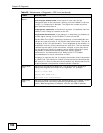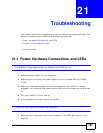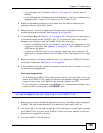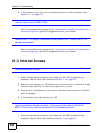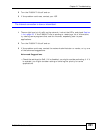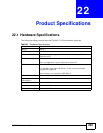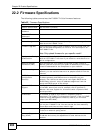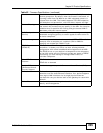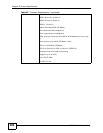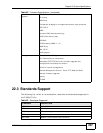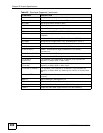
Chapter 22 Product Specifications
P-660H-T1v3s User’s Guide
204
22.2 Firmware Specifications
The following table summarizes the P-660H-T1v3s’s firmware features.
Table 62 Firmware Specifications
Default IP Address 192.168.1.1
Default Subnet Mask 255.255.255.0 (24 bits)
Default Admin
Password
1234
Static DHCP
Addresses
10
Static Routes 16
Device Management Use the web configurator to easily configure the rich range of
features on the P-660H-T1v3s.
Firmware Upgrade Download new firmware (when available) from the ZyXEL web site
and use the web configurator, an FTP or a TFTP tool to put it on
the P-660H-T1v3s.
Note: Only upload firmware for your specific model!
Configuration Backup
& Restoration
Make a copy of the P-660H-T1v3s’s configuration. You can put it
back on the P-660H-T1v3s later if you decide to revert back to an
earlier configuration.
Network Address
Translation (NAT)
Each computer on your network must have its own unique IP
address. Use NAT to convert your public IP address(es) to multiple
private IP addresses for the computers on your network.
Port Forwarding If you have a server (mail or web server for example) on your
network, you can use this feature to let people access it from the
Internet.
DHCP (Dynamic Host
Configuration
Protocol)
Use this feature to have the P-660H-T1v3s assign IP addresses, an
IP default gateway and DNS servers to computers on your
network. Your device can also act as a surrogate DHCP server
(DHCP Relay) where it relays IP address assignment from the
actual real DHCP server to the clients.
Dynamic DNS
Support
With Dynamic DNS (Domain Name System) support, you can use
a fixed URL, www.zyxel.com for example, with a dynamic IP
address. You must register for this service with a Dynamic DNS
service provider.
IP Multicast IP multicast is used to send traffic to a specific group of
computers. The P-660H-T1v3s supports versions 1 and 2 of IGMP
(Internet Group Management Protocol) used to join multicast
groups (see RFC 2236).
Time and Date Get the current time and date from an external server when you
turn on your P-660H-T1v3s. You can also set the time manually.
These dates and times are then used in logs.
Logs Use logs for troubleshooting. You can send logs from the P-660H-
T1v3s to an external syslog server.
Universal Plug and
Play (UPnP)
A UPnP-enabled device can dynamically join a network, obtain an
IP address and convey its capabilities to other devices on the
network.



